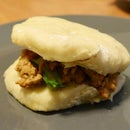Introduction: Convert Any Picture Into 3D Decoupage
Making your own 3D decoupage cards is a really fun hobby and a great way to show someone special how much you care about them. However, the kits you find in craft stores tend to be limited to flowers and the occasional teddy bear - so I started making my own.
This instructable will show you how to take any image and turn it into a 3D card topper - with a bit more personality than usual!
Supplies
- Gimp or similar image editor
- White paper or card (the thicker, the better)
- Printer
- 3D foam adhesives (optional)
- Small scissors / craft knife
Step 1: Prepare Reference Image
First up, you'll need a picture that you want to make into your 3D decoupage. In my case, I took my little doodle of Pikachu with some cute balloons but you can use almost anything. Personally, I find that having clear line-art & high resolution make the next steps easier. Images with a clear background and multiple foreground subjects tend to work really nicely.
Step 2: Split Into Layers
This is where having software like Gimp is really handy. However, if you prefer to cut out the parts by hand, you can skip this step and instead print the original image several times, cutting the section you want from each. Doing this digitally does make selecting the layers much easier and wastes less ink and paper though.
I recommend using no more than 4 layers + a flat background if you're using your art for a card. (Any more and it probably won't fit inside an envelope.)
- Open the original image in Gimp.
- Add alpha channel.
- Duplicate the 1st layer.
- Set the 1st layer opacity to ~20%.
- In the new layer (No. 4 in image above), erase the background. If your original image had a white background, this is easily done using the Fuzzy Select tool on the background and cutting it out.
- Duplicate the current layer and set its opacity to ~20%.
- Erase the unwanted parts of the new layer (the parts that should sit further back, when it's 3D).
- Repeat steps 6 & 7 until you have the desired number of layers.
- Reset all layer opacities to 100%, then rearrange the layers side-by-side and export as .jpg or .png, ready for printing.
Step 3: Print and Cut Out Layers
Now it's time to print off your layers! The thicker the paper you can print onto, the better but this may be limited by what your printer can handle.
I recommend cutting the page into squares around each layer first, so you're less likely to crease the layer adjacent to the one you're cutting. Small nail scissors can be really useful for the tight corners, or a small craft knife.
Cut out each layer one by one, either setting them aside in clear piles by layer or sticking each layer down after cutting it (see next step).
Step 4: Stack and Stick
Here's where all your hard work comes together! I recommend starting from the base and working your way up.
The easiest way to stack the layers is using 3D Foam Adhesives but if you can't find any, you can substitute them with some tiny paper springs:
Cut a thin strip of paper, fold it into a little 'Z' shape, add a dab of PVA to one end and let it dry slightly before attaching it to the underneath of the decoupage piece. Once you have as many springs as you need on any one piece, brush a dab of glue onto each exposed spring end and stick it onto the layer below.
Congratulations! Your 3D decoupage card topper is now complete!




